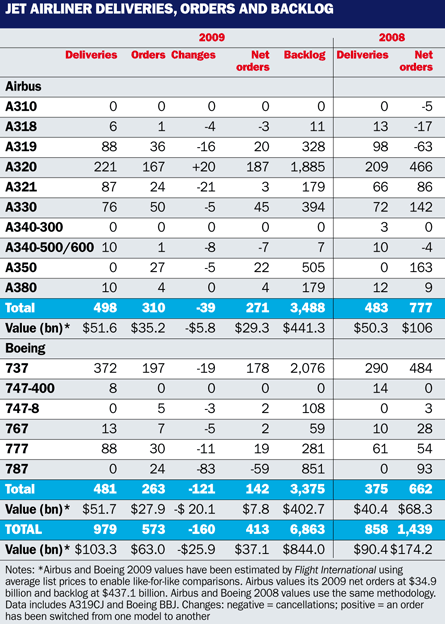There was no hiding Airbus boss Tom Enders' glee this month at the Airbus/EADS annual conference in Seville when he confirmed that the airframer had defied "the so-called experts" and rather than slashing production by 30%, had kept its nerve and broken all its records in 2009.
It was a different story on sales, with both airframers suffering a significant decline in orders as the industry hit the buffers, and no recovery is expected before 2012.
Enders' confirmation was what we have all expected for some time, that the "big two's" combined output hit a new all-time high, despite the global economy being at an all-time low. Between them Airbus and Boeing delivered just one aircraft shy of 980 in 2009, a 14% rise on the previous year, and 7% above the previous record of 914 shipments exactly 10 years earlier.
On that occasion, Boeing was the lead producer (to the tune of 620 units versus 294 for Airbus). This time it is the European airframer that had the bragging rights, delivering 498 aircraft against 481 for its rival. This means that not only had Airbus matched its 2008 level of 483 aircraft, but had actually delivered 15 units more.
Last year's combined tally is slightly skewed by the fact that Boeing's 2008 shipments were hit by the industrial stoppage, meaning that a number of deliveries were pushed into the following year. However it is an achievement for the two airframers, given the state of the industry cycle.
 |
|---|
Enders, backed by his chief salesman John Leahy, says the aim is to keep production stable through the current slump, as it did in the last downturn after 9/11 - albeit then at much lower volumes. He ascribes the airframer's success in 2009, which defied the logic of many industry observers who predicted that production would decline, to the many delivery slot swaps that Airbus negotiated during the year.
"Since the crisis began 18 months ago, we have rescheduled - postponed or brought forward - roughly 600 aircraft for the 2009-11 period," says Enders. This drive also helped keep order cancellations to a minimum.
Enders also says he wants to "pay tribute" to the support received from financial institutions and the European export credit agencies that helped it keep deliveries moving.
Airbus's aim this year is to keep production "roughly at the "2008-09 levels" [ie 480-500 aircraft], although Enders concedes that "much depends on the continuing recovery of the economy and our airline customers".
Louis Gallois, who is chief executive of Airbus's parent EADS, acknowledges that 2010 will be "a challenging year" and says that Airbus "will assess more clearly where we stand at the end of the winter season".
Leahy adds that "the goal is, by moving aircraft forward and back, to keep production relatively flat at the current levels through this downturn".
Despite the strong output performance, it was not all good news at the Airbus delivery centres, with Enders conceding that the "over-complexity" of producing the A380 continues to give production headaches. "At the beginning of the year we had planned to deliver 18 aircraft - that number was revised down to 14 because some airlines wanted to defer aircraft - but in the end we delivered 10," he says.
Airbus had revised the figure down several times during 2009 - partly due to production issues and because of customer requests to defer deliveries, which required some rejigging during the assembly process - but it still missed its final 2009 target by three aircraft.
This may not sound much, but in value terms, one A380 is the equivalent of up to five single-aisles (and 10 in terms of the production/delivery effort), so a margin of that nature is not inconsiderable on such a high-value programme.
Following a bottom-up review, the production issues have been addressed through more focused quality control and focused engineering support for the production line. "Our target is clearly to deliver at least 20 A380s in 2010," says Enders.
Airbus's strong output performance was led by the A320 family, with deliveries exceeding 400 for the first time - and output was 8% ahead of the 372 achieved by its rival, the Boeing 737. However it was Boeing that led the way in widebody production, shipping 109 747s, 767s and 777s against Airbus's 96 A330/A340s and A380s.
Overall, the order intake decline was not as bad as had been feared earlier in 2009. Airbus was again in charge, selling 310 aircraft against 263 for its rival, which meant that it was pleasantly surprised to achieve its 300 gross order target set at the beginning of last year. However Enders assures us that Airbus "has not compromised pricing" to prop up sales.
The combined net order total was affected by Boeing's high cancellation rate (largely down to the 787's problems), which declined 70% from 1,439 aircraft in 2008 to 413 in 2009. Airbus lost just 39 orders, reducing its net order tally to 271, while Boeing suffered 121 cancellations, dragging its net total to 142.
Airbus had its usual strong finish to the year, booking 85 orders in December. However, this does not indicate the recovery is on its way, and Leahy is resigned to the fact that the industry's appetite for orders will not begin "ramping back up" before 2012. He expects that Airbus can hope to book 250-300 orders this year.
Although the Airbus product line boasts 2009's best-selling widebody in the form of the A330 (45 net orders), the Sun appears ready to set on the twinjet's four-engined sister, the A340. The 2009 order tally was in deficit (-7 orders), thanks largely to A340 stalwart Virgin Atlantic swapping its six remaining -600s for A330s, pushing the backlog into single figures. So without any new sales this year the quadjet faces the very real prospect of becoming defunct.
Source: Flight International
















